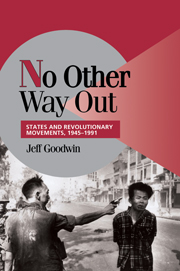Book contents
- Frontmatter
- Contents
- Figures, Tables, and Maps
- Abbreviations and Acronyms
- Preface and Acknowledgments
- Part 1 Introduction
- Part 2 Southeast Asia
- CHRONOLOGY FOR SOUTHEAST ASIA
- 3 THE FORMATION OF REVOLUTIONARY MOVEMENTS IN SOUTHEAST ASIA
- 4 THE ONLY DOMINO: THE VIETNAMESE REVOLUTION IN COMPARATIVE PERSPECTIVE
- Part 3 Central America
- Part 4 Further Comparisons and Theoretical Elaborations
- Annotated Bibliography
- Index
- Titles in the series
3 - THE FORMATION OF REVOLUTIONARY MOVEMENTS IN SOUTHEAST ASIA
Published online by Cambridge University Press: 05 June 2012
- Frontmatter
- Contents
- Figures, Tables, and Maps
- Abbreviations and Acronyms
- Preface and Acknowledgments
- Part 1 Introduction
- Part 2 Southeast Asia
- CHRONOLOGY FOR SOUTHEAST ASIA
- 3 THE FORMATION OF REVOLUTIONARY MOVEMENTS IN SOUTHEAST ASIA
- 4 THE ONLY DOMINO: THE VIETNAMESE REVOLUTION IN COMPARATIVE PERSPECTIVE
- Part 3 Central America
- Part 4 Further Comparisons and Theoretical Elaborations
- Annotated Bibliography
- Index
- Titles in the series
Summary
The Pacific War created an entirely new pattern in Southeast Asian politics – so much so that the observer who was fairly closely in touch with the situation in 1940 would, if he did not return to Southeast Asia until 1948 and had not kept himself up to date with a close study of reports, find himself unable to recognise what he saw.
– Victor Purcell (1965: 551)This chapter presents a state-centered explanation of the uneven development of armed, Communist-led revolutionary movements in Southeast Asia in the aftermath of the Second World War. More specifically, it attempts to explain why Communist movements became formidable threats to incumbent regimes in Vietnam, Malaya, and the Philippines during the decade or so following World War II, but not in Indonesia. The following chapter attempts to explain why only the Vietnamese Communist insurgency was subsequently able to seize state power (at least, during the period under examination, in northern Vietnam), while the other two Communist insurgencies that developed in the region were defeated.
After noting some of the common characteristics of Southeast Asian societies at midcentury, I examine two hypotheses about “Indonesian exceptionalism” (i.e., the absence of a Communist-led national liberation movement in that country), and present my own solution to this puzzle.
- Type
- Chapter
- Information
- No Other Way OutStates and Revolutionary Movements, 1945–1991, pp. 72 - 105Publisher: Cambridge University PressPrint publication year: 2001



